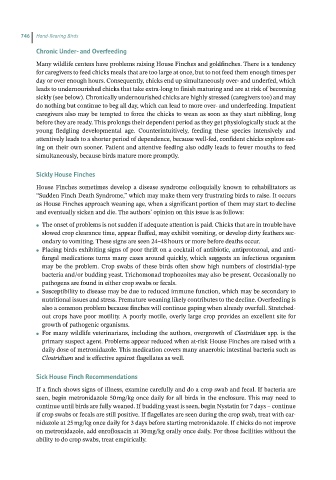Page 744 - Hand rearing birds second
P. 744
746 Hand-Rearing Birds
Chronic Under- and Overfeeding
Many wildlife centers have problems raising House Finches and goldfinches. There is a tendency
for caregivers to feed chicks meals that are too large at once, but to not feed them enough times per
day or over enough hours. Consequently, chicks end up simultaneously over‐ and underfed, which
leads to undernourished chicks that take extra‐long to finish maturing and are at risk of becoming
sickly (see below). Chronically undernourished chicks are highly stressed (caregivers too) and may
do nothing but continue to beg all day, which can lead to more over‐ and underfeeding. Impatient
caregivers also may be tempted to force the chicks to wean as soon as they start nibbling, long
before they are ready. This prolongs their dependent period as they get physiologically stuck at the
young fledgling developmental age. Counterintuitively, feeding these species intensively and
attentively leads to a shorter period of dependence, because well‐fed, confident chicks explore eat-
ing on their own sooner. Patient and attentive feeding also oddly leads to fewer mouths to feed
simultaneously, because birds mature more promptly.
Sickly House Finches
House Finches sometimes develop a disease syndrome colloquially known to rehabilitators as
“Sudden Finch Death Syndrome,” which may make them very frustrating birds to raise. It occurs
as House Finches approach weaning age, when a significant portion of them may start to decline
and eventually sicken and die. The authors’ opinion on this issue is as follows:
The onset of problems is not sudden if adequate attention is paid. Chicks that are in trouble have
●
slowed crop clearance time, appear fluffed, may exhibit vomiting, or develop dirty feathers sec-
ondary to vomiting. These signs are seen 24–48 hours or more before deaths occur.
● Placing birds exhibiting signs of poor thrift on a cocktail of antibiotic, antiprotozoal, and anti-
fungal medications turns many cases around quickly, which suggests an infectious organism
may be the problem. Crop swabs of these birds often show high numbers of clostridial‐type
bacteria and/or budding yeast. Trichomonad trophozoites may also be present. Occasionally no
pathogens are found in either crop swabs or fecals.
Susceptibility to disease may be due to reduced immune function, which may be secondary to
●
nutritional issues and stress. Premature weaning likely contributes to the decline. Overfeeding is
also a common problem because finches will continue gaping when already overfull. Stretched‐
out crops have poor motility. A poorly motile, overly large crop provides an excellent site for
growth of pathogenic organisms.
For many wildlife veterinarians, including the authors, overgrowth of Clostridium spp. is the
●
primary suspect agent. Problems appear reduced when at‐risk House Finches are raised with a
daily dose of metronidazole. This medication covers many anaerobic intestinal bacteria such as
Clostridium and is effective against flagellates as well.
Sick House Finch Recommendations
If a finch shows signs of illness, examine carefully and do a crop swab and fecal. If bacteria are
seen, begin metronidazole 50 mg/kg once daily for all birds in the enclosure. This may need to
continue until birds are fully weaned. If budding yeast is seen, begin Nystatin for 7 days – continue
if crop swabs or fecals are still positive. If flagellates are seen during the crop swab, treat with car-
nidazole at 25 mg/kg once daily for 3 days before starting metronidazole. If chicks do not improve
on metronidazole, add enrofloxacin at 30 mg/kg orally once daily. For those facilities without the
ability to do crop swabs, treat empirically.

